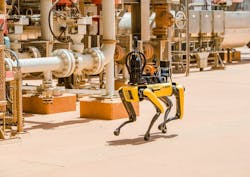At just 10 years old, Woodside Energy’s Pluto liquid natural gas (LNG) plant on the northwest coast of Australia is just a kid compared to most similar facilities. And, because it’s so young, it’s also more technically advanced than its peers, which aids in producing 4.9 million tons of LNG per year from two offshore gas fields.
To identify issues that could cause downtime earlier and more often, Woodside recently added to Pluto’s advances by launching a new, data-capture service at the plant. This project included deploying Boston Dynamics’ four-legged Spot robot as part of its Spector program. The robot is assigned to conduct routine, sitewide inspections. Its payloads include Spot Cam+IR with a 30x optical zoom camera and a thermal camera to detect if equipment may overheat. Spot captures images that complete regulatory, visual inspections for electrical devices.
Get your subscription to Control's tri-weekly newsletter.
Woodside also worked with DroneDeploy to implement the robot’s link with Pluto’s in-house digital twin. Spot moves autonomously through the plant, navigating obstacles, and righting itself when it stumbles.
“Spector goes and finds information, and we access it and run analytics,” says Shawn Fernando, remote operation delivery manager at Pluto. “This gives our operators a detailed view of what they need to do next.”
Spot also has a customized safety payload that allows it to operate in classified, hazardous locations in accordance with legal requirements and Woodside’s risk assessment procedures and policies. For example, if the robot senses gas during an inspection or elsewhere onsite, the safety payload will immediately shut it down by electrically isolating the battery.
Before the Spector program, it could take up to 90 minutes to find equipment and complete an end-to-end visual inspection of it. With Spot, inspectors can review images first to determine their response and bring exactly what they need.
“One of the biggest benefits of robot-captured images is that they can be used to identify issues before we arrive in the field,” adds Bruce Hill, electrical inspection coordinator at Woodside. “This means we can bring spares, fix any issues as soon as possible, and save even more time.”
This is part three of Control's February 2025 edge computing cover story. Read all the cover story installments here.


